Category: Research
PhD’ing – Taboo, Tinkle, Algorithms, and Home
For an autobiographical project building off Leaky Objects, in which I’m allowing myself to undertake a significantly slow design process, this week I read Geography of Home: Writings on Where We Live by Akiko Busch. The book is a collection of beautiful musings organized by room and touches upon notions of comfort, dichotomies between possessions and spaces, clutter, deeply personal rituals, thresholds, processions, and changing functionalities. So much I love in this book while mapping the geography of our tiny home which defies all traditional expectations and conditions. Last year before moving from London to Stockholm, we read The Life-Changing Magic of Tidying Up, an amusing read that we nevertheless abided by and asked everything we own, “Do you bring me joy?” Not only did we end up giving away bags of stuff, but it also prompted many meaningful discussions regarding and aligning views on possessions and a home, in addition to musings around if someday everything will be connected, will all our possessions? And why do we keep them, and do we deserve them if possession implies care, custody, and guardianship? More and more through many of my ongoing projects and initial concepts, I realize I’m interested in overlaps between privacy and care, and perhaps comfort too.
A project I recently started with MSc students is investigating predicting pee habits, which to many is a taboo topic due to the invasive nature of the proposed interaction and an aversion to recognizing private bodily functions. A subsequent discussion with my supervisor on researching taboo topics led to the reading of the paper Accountabilities of Presence: Reframing Location-Based Systems and the website Between the Bars: Human Stories from Prison. In the paper, the authors research paroled sex offenders who are tracked via GPS to explore the intersection between mobility, presence, and privacy; while the website offers a digital platform to share handwritten content from people in prison who do not have access to internet. In both cases, what could be considered extreme or fringe users are researched or designed for, and equally interesting for different reasons, they also serve as interesting case studies that either directly learn from or address the messy realities of society. One of my biggest peeves – designers don’t address the messiness of life nearly enough. So while pee might not be prison, it is definitely an everyday and occasionally very messy, mundane, and universal reality that should not be ignored as I believe there is much to be gained from deviating from designing only delightful experiences.
On a fun, related note, I recently found out that Engelbart conceived what he called the “tinkle toy”, a small waterwheel in a toilet bowl that would spin when pee was run over it, serving as a potty-training aid for boys as the interaction was designed to be an incentive to pee in the toilet. From Markoff’s What the Dormouse Said: How the Sixties Counterculture Shaped the Personal Computer Industry.
A week or two ago, it was difficult to miss Algorithms as culture: Some tactics for the ethnography of algorithmic systems on Twitter. Found it incredibly informative and a nice compliment to Dourish’s The Stuff of Bits: An Essay on the Materialities of Information, which I started last week for implicit interaction book club. The paper also led me to these slides The algorithm multiple, the algorithm material: Reconstructing Creative Practice – in which I was thrilled to see my former UVa architecture professor and brief employer Jason Johnson of Future Cities Lab mentioned.
Lastly, this morning I found this open source software by Rebecca Fiebrink for real-time, interactive Machine Learning that hopefully I can use with Arduino.
DIS 2017 – Poster Presentation of Leaky Objects
Last week at DIS 2017 in Edinburgh I presented a poster (pdf) for my work-in-progress Leaky Objects: Implicit Information, Unintentional Communication. Very thankful for the discussions and feedback!
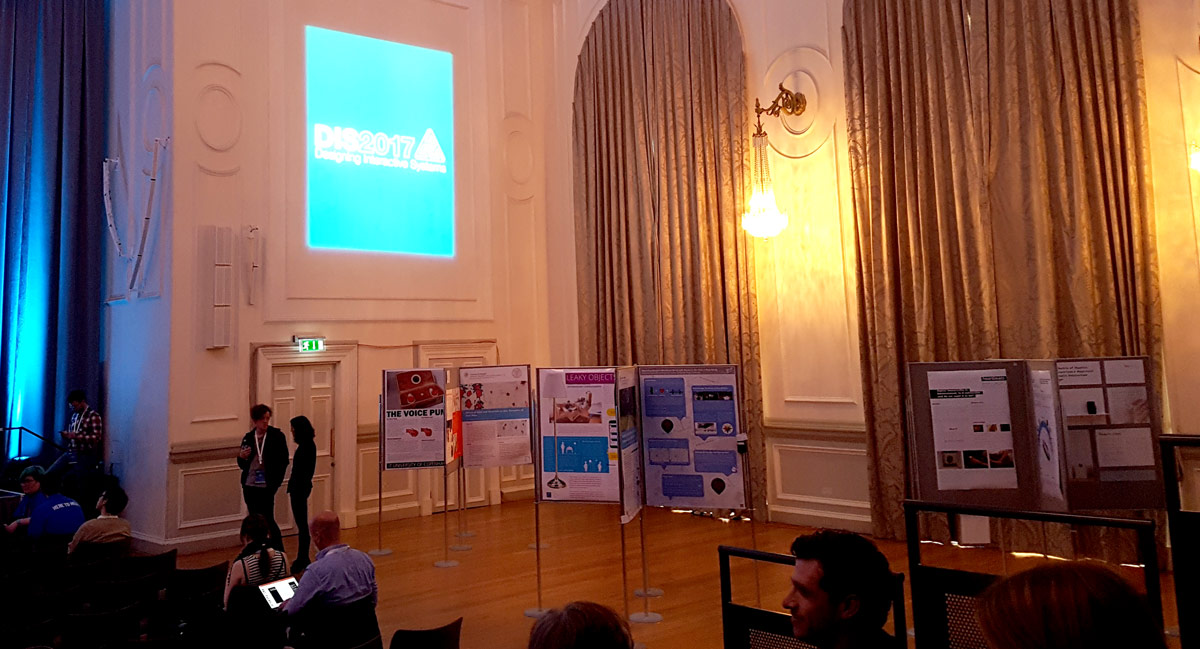
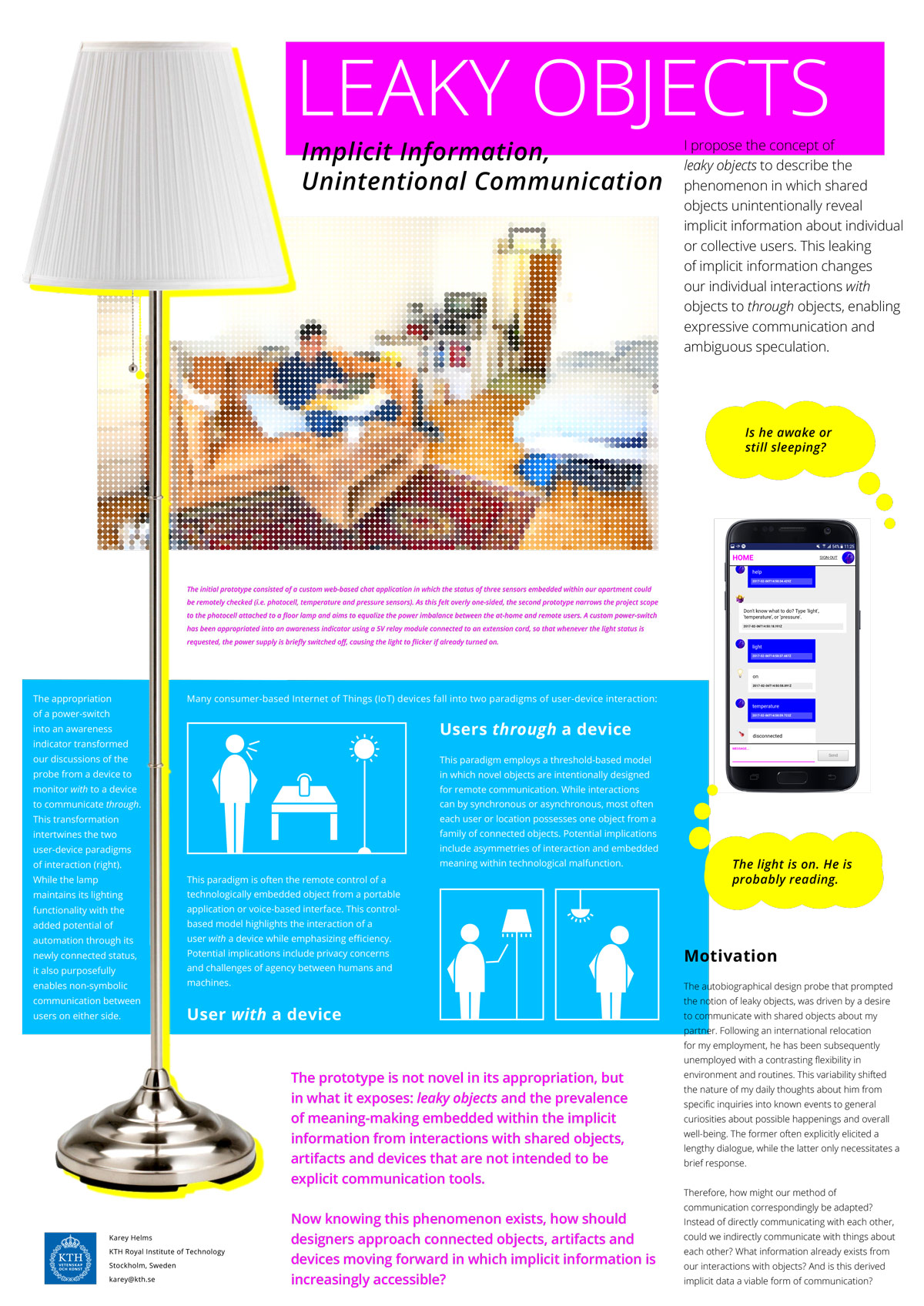
DIS 2017 – Accepted Works-in-Progress (PWiP)
Both very unexpected and exciting to have a work-in-progress accepted to DIS 2017 in Edinburgh. I wrote about an ongoing autobiographical design project that was started this spring along side a few other explorations to kick-start my PhD at KTH this year. Very thankful to Kia Höök who talked me through my insight at a KTH Interaction Design writer’s camp in March and the reviewers who gave great feedback on how to continue developing it into a full paper.
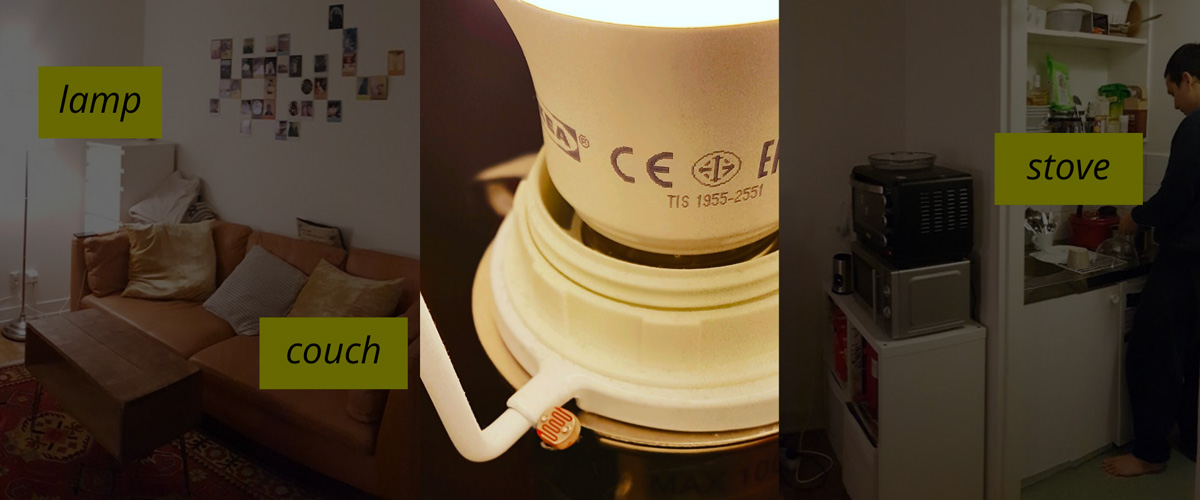
Leaky Objects: Implicit Information, Unintentional Communication (PDF)
This paper introduces the concept of leaky objects to describe this phenomenon in which shared objects unintentionally reveal implicit information about individual or collective users. This leaking of implicit information changes our individual interactions with objects to through objects, enabling expressive communication and ambiguous speculation. The aim of this paper is raise awareness of this phenomenon through an ongoing autobiographical design probe in which remote interpersonal communication through a connected object is being explored, and raise questions regarding the potential implications for designers.
CHI 2017 – Attending Two Workshops
Very excited that I’ll be attending two workshops at CHI’17 in Denver! Below are links to the workshop descriptions and my position papers.
Workshop 1 – Making Home: Asserting Agency in the Age of IoT (description)
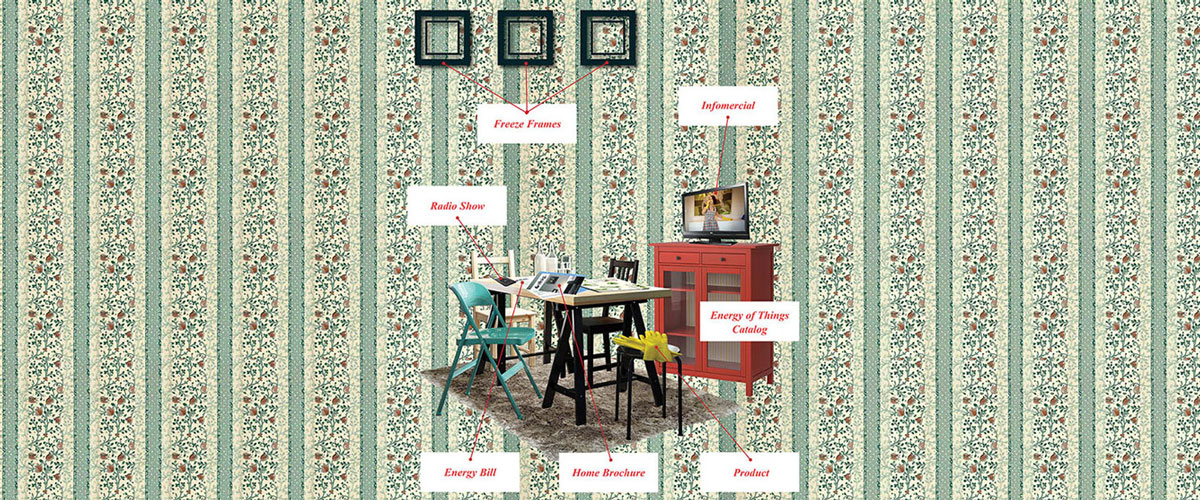
The Family Circuit: A New Narrative of American Domesticity (position paper PDF)
As the world endures and approaches a string of energy crises, The Family Circuit: A New Narrative of American Domesticity, aims to critique and challenge society’s relationship with energy by provoking individuals to examine their current habits of energy consumption, consider the future implications of these actions, and question their willingness to make sacrifices for a cleaner environment. This is accomplished through the development of a fictional near future society in which individuals are required to produce all the electrical energy that they need or desire to consume. Within the daily narrative of a fictional family of five, the events of their domestic lives have been extrapolated to create a liminal world where mundane, yet peculiar diegetic prototypes create tense situations, uncomfortable behaviors, and unforeseen consequences. The project raises questions regarding local to global contextual considerations, behavioral change within the home diegesis, and hyper-localized hacking.
Workshop 2 – Designing the Social Internet of Things (description)
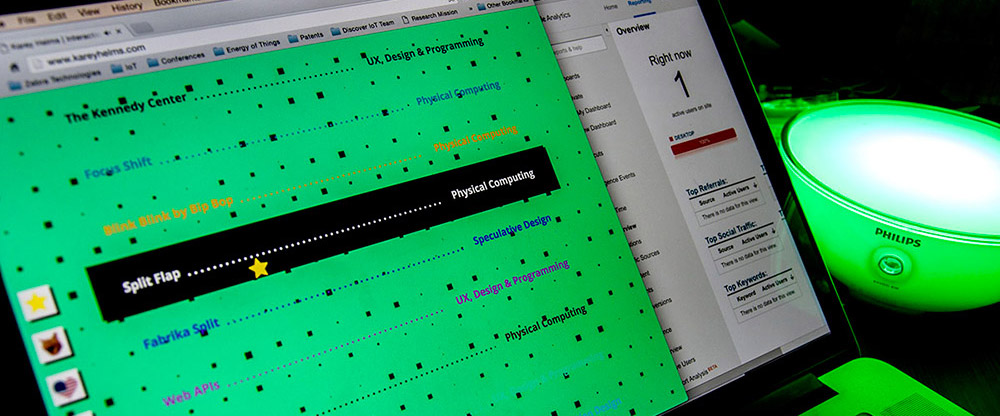
Phygital Party Mode: A Relationship with Relationships (position paper PDF)
In this position paper, I present an exploratory autobiographical design project, Phygital Party Mode, in which visitors’ interactions with my website remotely control an Internet of Things light within my apartment. I reflect upon my relationship with the project as a ‘thing’ and explore the themes of active versus reactive agency, conditional relationships and designing the behaviors of objects. Finally, I end with discussion questions that address a transfer of agency due the democratization of the Internet of Things, the transformation of relationships with and because of connected ‘things,’ and the empowerment of people over objects.
Industry to Academia, London to Stockholm
This week marks a big transition as I leave the complexities of enterprise UX at Zebra Technologies to pursue a PhD in Smart Implicit Interaction at KTH in Stockholm as part of a newly formed research group. My academic statement of intent below perhaps best expresses the culmination of my past experiences leading to my forthcoming journey. And the photo is of course just one of the many fond memories I will take with me.

Statement of Intent
“You think that because you understand ‘one’ that you must therefore understand ‘two’ because one and one make two. But you forget that you must also understand ‘and’.” ~ Sufi teaching story (Meadows, 2008)
Interests
On my first day of architecture school, we were asked to diagram where we come from and where we are now using a only a series of lines and dots on index cards. At the time, I was baffled by the task of reducing a complex, dynamic, and intimate answer into such simplistic, static, and impersonal elements. While this assignment ultimately ignited my interest in the pieces and processes of emergent systems and how the unique relationships between individual components inform and define the greater whole; more importantly, it cultivated analytical and divergent thinking. I learned how to isolate core components from a system, define explicit interactions in a space, situate functions within a context, and map parametric flows across time. Though eventually, my career pivoted from architecture to design as my intent transitioned from delight to meaning, and thus my thinking transformed from analytical to synthetic.
The primary differentiator between my experiences in architecture and design has been the latter’s focus on creative problem solving, or the convergence of disparate elements, activities, and intents to foster meaning. People have become the focus and embodied interaction the goal as I have strived to understand how space becomes place and appearance becomes presence. As an Interaction Designer, I design how people interact with, through, or without technology – an infinite and inclusive definition that ultimately focuses on people and prepositions, as it is the relationships that concern me. But as objects, environments, and worlds become ubiquitously intelligent, networked, and augmented, these relationships become increasingly dynamic, contextual, and intangible. I believe that negotiating these evolving relationships – to ultimately design meaningful new interaction modalities – is an exciting, challenging, and significant opportunity. Thus, I am interested in architecting the synthetic.
Pervasive and with unbounded potential, the “Internet of Things” is the key catalyst and instantiation of this paradigm shift towards implicit interactions. Moreover, as IoT infiltrates the mundane moments of our daily lives, it has the ability to transform our quality of life and achieve efficacious new futures from life-saving wearables to intelligent infrastructures. Though due to its systemic and embedded nature, both participative frameworks and contextual interventions are needed (as interaction is reciprocal), and thus both designs and the environments by which designers and users occupy, must be regarded. This duality necessitates divergent and convergent thinking, with a careful consideration of constraints, contexts, and intents. Therefore, through critical practice, ethnographic research, and situated prototypes, I aspire to explore what could be and what should be the intelligent dialogues of mediated, smart environments.
Capabilities
Over the past decade I have been afforded opportunities professionally, academically, and independently to cultivate the necessary skillset for the pursuit of a PhD in Interaction Design. Following the completion of my BS in Architecture, for over four years I was primarily self-employed as an Interaction Designer and Front-end Developer, working directly with clients from contract to concept to deployment. During this time, I was fortunate to work with a vast array of clients, expanding my formal digital design skills encompassing personas, user flows, information architecture, visual design, and UI development. Though more importantly, the empirical knowledge gained – pertaining to interpersonal and leadership skills, rigorous self-directed scheduling, and end-to-end digital product management and development – has been most invaluable.
My return to academia for my MFA in Interaction Design at Umeå University in 2012 was sparked by a desire to merge my physical and digital backgrounds within a formal user-centered education. My time in Umeå was marked by diverse and immersive collaborations with both peers and industry partners alike, who provided boundless intellectual stimulation while broadening my perspectives. I learned how to think critically and share imaginatively, perhaps best demonstrated in my speculative design thesis. Driven by a passion to critique and challenge society’s relationship with energy, I constructed a near future fictional society in which citizens are required to produce all the energy they desire to consume. Through liminal spaces and diegetic prototypes, I provoked polemical and productive dialogues, which were an engaging end to a wonderful graduate experience.
Following Umeå I moved to London and became a Senior Interaction Designer on the Innovation and Design Team at Zebra Technologies, an enterprise Internet of Things company. Within the constraints of business co-creation and the freedom of internal initiatives, my work investigates a product shift from isolated hardware and software to integrated systems and agents. In particular, I seek to design appropriate solutions at relevant fidelities that can enhance the cognitive and physical abilities of situationally disabled users in data-centric environments. For example, I am the Design Lead in a long-term co-creation project with a global transportation and logistics company seeking to improve organizational and workflow processes through custom 3D imaging technology and edge analytics. Besides traditional UX deliverables, my role includes ethnographic research, empathy mapping, stakeholder communication, service design, and a constant negotiation between implementable and transformational near future visions.
In addition to my role at Zebra, I actively engage in personal side projects which I playfully call “self-centered design.” Within these hypercritical explorations, I prototype manifestations of invisible interactions from the mundane moments of my daily life to gain insights into embodied interaction and socio-technical systems. Two ongoing projects are “Phygital Party Mode” and “Burrito.” The former is a phygital representation of online visitors’ interactions with my portfolio via Google Polymer, Firebase, Arduino, and Philips Hue technologies. Burrito is a manifestation of my marriage in the form of a bot that makes judgements on our relationship based on a mutually defined algorithm. Though perhaps a bit bonkers, both prototypes have resulted in instrumental insights that technically and creatively impact my professional development.
Motivation
My motivation to be a doctoral student is a combination of passion for the subject, drive to innovate in an immersive environment, desire to collaborate on a highly capable and motivated research team, and aspiration to contribute to academia via teaching. Throughout my educational background thus far, I have been fortunate to learn, collaborate, and contribute within competitive academic environments that seek and attain meaningful innovation. At both the University of Virginia and Umeå Institute of Design, I experienced firsthand the productive synthesis of cross-disciplinary participation and student-faculty engagement. These relationships were not only instrumental in my own development, but more importantly, contributed to the progress of meaningful experiences, emerging technology, and imaginative new futures. With diligent analysis and thoughtful synthesis, I would love to continue this trajectory at KTH with an inspiring team at a leading institution, and can guarantee that in addition to my credentials, I bring a healthy dose of gumption.
Meadows, Donella H. (2009). Thinking in Systems: a Primer. London, UK: Earthscan.
Research Presentation
Last Friday we had our thesis research presentations, which was both a great opportunity for us individually to analyze and consolidate our findings, as well as get back up to speed on the status of others in the class. Below is an example slide from my presentation, displaying my established design principles resulting from research.

I found my post presentation feedback helpful in regards to exposing gaps in my research, holes in my presentation (information that is clear in my working report document but otherwise not explained verbally), and helping me plan next steps. Below are some feedback highlights:
- Give critical design background in presentation
- Be explicit about focus on indirect or direct electricity use
- Define scope of project also on what I don’t want to do
- Decide on a specific context
- Recommended read: Objects of Desire
As I have tentatively decided on a domestic context to stage my energy production/consumption scenarios, my primary next step will be to host an ideation workshop next week. In addition, I will be spending a lot of time in the upcoming days updating my written in progress report and be researching prototyping materials as I need to place an order sooner rather than later.
Download my research presentation slides.
For further curiosity, you can also read my initial brief.
Daily Energy Interactions
A main component of my thesis research is the understanding of the existing mechanisms within the individual’s current relationship with energy. With an initial focus on basic interactions with electricity, over the course of a week I self documented three 24 hour periods with cellphone photographs. As my project deals with the direct individual experience of energy, I tried to both document and analyze based on a phenomenological perspective with Don Ihde’s four human-technology relations in mind. In addition to self studies, I also asked friends and family members outside of school to document their interactions with energy, photographing the physical interaction, environment, and furthest trace of electricity. An overwhelming fourteen people participated!

For further curiosity, you can also read my initial brief.